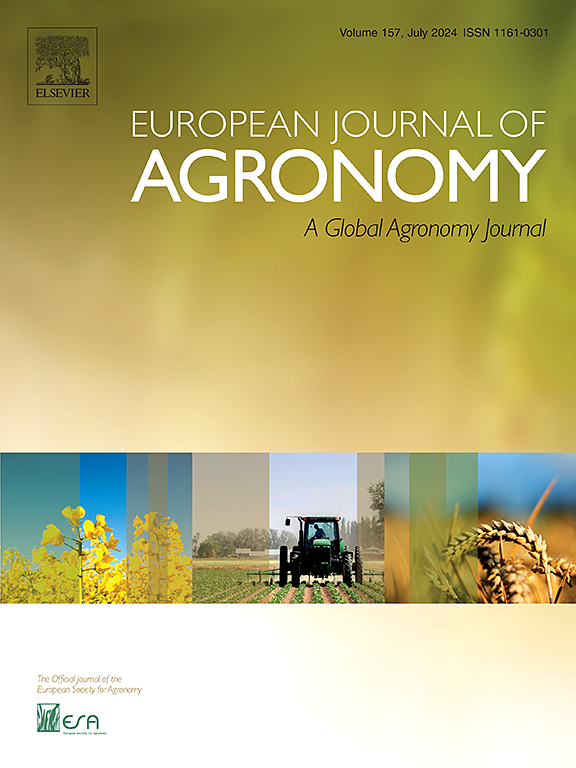施肥和缺营养条件下冬小麦茎和根的表型可塑性
IF 5.5
1区 农林科学
Q1 AGRONOMY
引用次数: 0
摘要
虽然人们普遍认识到氮(N)、磷(P)和钾(K)的添加和石灰化对农业高产和土壤肥力至关重要,但研究芽根对营养缺乏反应的实地研究仍然有限。了解作物对贫瘠土壤的适应策略对于优化低投入农业至关重要。本研究以德国Dikopshof为研究对象,对2019/20和2020/21两个生育期的冬小麦进行了长期施肥试验,在不施肥和特定不施氮、磷、钾和石灰的情况下,采用两种全肥处理(NPKCa不施和加农家肥),研究了冬小麦的茎部和根系响应。分析了作物物候、叶面积指数(LAI)、株高、茎部生物量、籽粒和秸秆产量、根系生物量、根长、根长密度(RLD)、根冠比(R/S)、比叶面积(SLA)、比根长(SRL)和每梢生物量根长。结果表明,在两个生育期,全肥处理的茎部性状、根长和根系生物量均最高。不施肥和免氮处理导致地上部生物量、叶面积指数、株高、产量、根长和根系生物量下降,而SRL、R/S和每地上部生物量根长增加。不施用磷、钾和石灰降低了秸秆产量。我们的研究结果强调了养分缺乏、茎和根表现以及环境因素之间复杂的相互作用,强调需要进一步研究品种差异和更高时间分辨率的采样,以提高作物生产力和养分管理策略。本文章由计算机程序翻译,如有差异,请以英文原文为准。
Winter wheat shoot and root phenotypic plasticity under fertilized and nutrient-deficient field conditions
While it is widely recognized that nitrogen (N), phosphorus (P), and potassium (K) addition, and liming are crucial for high agricultural yields and soil fertility, field studies examining shoot-root responses to nutrient deficiencies remain limited. Understanding crop adaptation strategies to nutrient-poor soils is crucial for optimizing low-input agriculture. In this study, we investigated the shoot and root responses of winter wheat cultivated in two growing periods (2019/20 and 2020/21) at the long-term fertilizer experiment in Dikopshof, Germany, under no fertilization, or specific omission of N, P, K, and liming with two fully fertilized treatments (NPKCa without and with farmyard manure). We analyzed crop phenology, leaf area index (LAI), plant height, shoot biomass, grain and straw yield, root biomass, root length, root length density (RLD), root-to-shoot ratio (R/S), specific leaf area (SLA), specific root length (SRL) and root length per shoot biomass. Our results showed that the fully fertilized treatment with manure consistently had the highest values for shoot traits, root length, and root biomass in both growing periods. The unfertilized and N omission treatments led to a decrease in shoot biomass, LAI, plant height, yield, root length, and root biomass while leading to an increase in SRL, R/S, and root length per shoot biomass. The omission of P, K, and liming reduced the straw yield. Our findings highlight the complex interactions between nutrient deficiencies, shoot and root performance, and environmental factors, emphasizing the need for further research on cultivar differences and higher temporal resolution sampling to enhance crop productivity and nutrient management strategies.
求助全文
通过发布文献求助,成功后即可免费获取论文全文。
去求助
来源期刊

European Journal of Agronomy
农林科学-农艺学
CiteScore
8.30
自引率
7.70%
发文量
187
审稿时长
4.5 months
期刊介绍:
The European Journal of Agronomy, the official journal of the European Society for Agronomy, publishes original research papers reporting experimental and theoretical contributions to field-based agronomy and crop science. The journal will consider research at the field level for agricultural, horticultural and tree crops, that uses comprehensive and explanatory approaches. The EJA covers the following topics:
crop physiology
crop production and management including irrigation, fertilization and soil management
agroclimatology and modelling
plant-soil relationships
crop quality and post-harvest physiology
farming and cropping systems
agroecosystems and the environment
crop-weed interactions and management
organic farming
horticultural crops
papers from the European Society for Agronomy bi-annual meetings
In determining the suitability of submitted articles for publication, particular scrutiny is placed on the degree of novelty and significance of the research and the extent to which it adds to existing knowledge in agronomy.
 求助内容:
求助内容: 应助结果提醒方式:
应助结果提醒方式:


